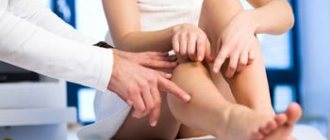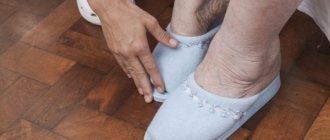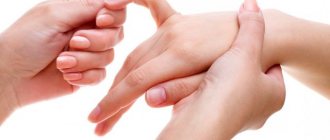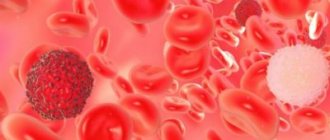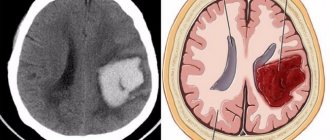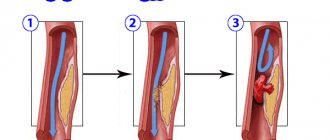Many patients often turn to doctors with complaints that their legs hurt after a heart attack, what to do? Indeed, after extensive heart attacks, edema of the lower extremities is a typical phenomenon. At first, excess fluid accumulates in the feet and legs of a person, but as heart failure progresses, they rise higher and higher, involving the hips and abdomen. In severe cases, anasarca occurs, when ascites (accumulation of fluid in the abdominal cavity), enlarged liver and hydrothorax (accumulation of fluid near the lungs, in the pleural cavity) are added to swelling of the legs. This indicates congestion in the systemic circulation.
Causes of leg swelling after a heart attack
After an MI, swelling in the legs may appear for the following reasons:
- increased fluid volume in the vascular system;
- decreased cardiac output;
- violation of venous outflow;
- increasing vascular resistance.
Whatever edema develops, an imbalance between the filtration of fluid from the vessels into the tissue and its reabsorption by the venous vessels is the main reason why the legs swell after a heart attack, and the treatment of this disease should take this mechanism into account.
After an MI, the human body changes seriously, and not only due to a decrease in the pumping function of the heart, but also because the hormonal levels change, affecting the functioning of the kidneys, which also begin to work worse. As a result, a weakened heart is forced to pump an increased volume of blood, which is why swelling of the legs occurs after a myocardial infarction.
Mechanism of edema development
According to the physiological theory, the mechanism for the appearance of edema due to cardiac problems is formed in stages:
- Heart failure appears.
Failures in the functioning of the heart or one of its parts lead to changes in the function of the muscle as a pump. So, the heart can no longer cope with the volumes of blood that are considered normal. As a result, blood tends to accumulate in the vessels that go to the heart. A stagnation mechanism is formed.
At the next stage, the mechanism of arterial blood deficiency joins the venous stagnation of blood. The body experiences a lack of oxygen and launches protective processes, activating the sympathetic parts of the nervous system.
In order for blood pressure to remain normal, the blood vessels begin to narrow. But this process leads to the fact that the kidneys do not have time to filter the entire volume of liquid. This is how its stagnation in the body develops, causing the appearance of edema.
Vascular permeability increases.
Late stages of heart failure, when the chronic form is diagnosed, are associated with liver damage as a result of stagnation of blood in the veins. Protein synthesis is disrupted and leads to a decrease in oncotic pressure.
As a result, water easily leaves the vessels. Heart failure is the trigger for the above pattern.
Treatment of swelling and pain in the legs after a heart attack
Non-drug treatment
Like many other ailments, post-infarction edema is easier to prevent than to treat it for a long time. With this in mind, the doctor, when discharging the patient from the hospital, leaves him with recommendations regarding his future lifestyle.
- drinking regimen . If a person has suffered a major MI and, in addition, has kidney problems, then he should not drink more than 1 liter of water per day. In the most severe cases, he even needs to compare the total volume of liquid he consumed with the volume of urine excreted during the day. These values should be approximately equal. You can also monitor the accumulation of fluid in the body - weigh yourself daily on an empty stomach and keep a corresponding diary.
- Nutrition . If your legs hurt after a heart attack, then you need to remove spicy and salty foods from your diet. Sodium from salt complicates the work of the kidneys, which make it worse for them to remove fluid outward, and as a result, edema begins to grow.
- Sedentary lifestyle . The third reason why legs hurt after a heart attack is physical inactivity - if the patient neglects even moderate physical activity. People who have had a heart attack definitely need leisurely walks in the fresh air. When the legs are in motion, their working muscles disperse blood through the veins and improve its outflow, which contributes to the disappearance of swelling.
- Compression underwear . If a person suffers from pain in the leg after a heart attack, then compression garments - tights, knee socks, stockings - can be very useful. Such preventive knitwear should be worn by people who have to stand on their feet for a long time. But only a doctor can recommend such underwear, and you can only buy it at a pharmacy.
Medicines for edema
What to do if swelling of the legs appears after a heart attack? They need to be treated not only by revising your lifestyle, but also with the help of drugs that increase the contractility of the heart muscle, reduce vascular tone, and also reduce the load on this organ.
The most important drugs in the fight against edema are, of course, diuretics (diuretic drugs). But you need to keep in mind that urine takes away many important elements from the body, such as magnesium and potassium. To replenish them, you need to take Panangin or related drugs.
After an MI, ACE inhibitor drugs are almost always prescribed, which not only stabilize blood pressure, but also help restore renal filtration to its lost balance.
To improve cardiac activity and reduce post-infarction edema, other groups of pharmacological agents are also used: digoxin and beta blockers. But all of the drugs listed above can only be prescribed by a doctor, and self-medication with them is unacceptable, since it can cause the most disastrous results.
Traditional medicine
For swelling of the legs, the main method of treatment, of course, should be drug therapy. But what to do if your legs swell after a heart attack, but you don’t want to take chemo or it’s simply contraindicated? Traditional medicine can also serve as a support or even a replacement, with the help of which it will be easier to remove excess fluid from the body, return to a full life and remove an annoying cosmetic defect. But even here it would be useful to consult with your doctor.
What not to do while traveling to prevent swelling
Sometimes a person himself provokes swelling of the legs, not on purpose. Here are a number of rules on what you should not do while traveling to avoid swelling:
- Do not drink alcohol. Drinking alcohol causes swelling and retains fluid in the body. Coupled with prolonged immobility, swelling cannot be avoided. Drink clean water and green tea, the drink removes toxins and excess water.
- Do not sit on your legs or with your legs crossed. Blood vessels are pinched, slowing down blood and lymph flow. In addition to swelling, a person will soon feel an unpleasant feeling of numbness and tingling.
- Avoid wearing tight shoes or high heels when traveling. If there is no way to remove shoes, a person will begin to experience severe discomfort and pain in the feet. Give preference to fabric sneakers and ballet shoes with flexible rubber soles to stretch your toes and slightly increase blood circulation.
Comfortable shoes
Symptoms
Why do the legs swell after a heart attack and what is the localization mechanism? Initially, excess fluid accumulates in the feet and kneecaps, and with the development of cardiac pathologies, the swelling rises. In this case, after a heart attack, the legs swell and symptoms can spread to the area of the femur and groin.
Often, the puffiness is symmetrical and grows evenly, from the ankle up to the shin. Most often, swelling of the legs after a heart attack intensifies in the evening and if you press on the skin with your finger, a hole remains for a long time. The legs are cold to the touch, limp, the skin has a tense appearance and a bluish tint.
Causes
The main factors that precede the formation of leg swelling after a heart attack include the following:
- Decreased cardiac output.
- Increased vascular resistance.
- An increase in the volume of intravascular fluid.
- Venous outflow dysfunction.
After a heart attack, the legs swell due to an imbalance in the absorption and filtration of fluid between the vessels and capillary walls. This is due to dysfunction of the pumping properties of the blood and a decrease in the performance of the cardiovascular system.
Alarming symptoms
There are a number of patient conditions when it is necessary to urgently consult a doctor:
- If the skin begins to turn red, and any touch causes severe pain. This indicates the development of an acute inflammatory process.
- Swelling of the legs after a heart attack grows to the knee, the skin acquires a bluish-transparent tint.
- If the skin temperature drops significantly.
- If you experience daily swelling of the extremities, you should urgently consult a doctor; this may indicate the development of varicose veins.
- When your face becomes puffy in the morning, more fluid accumulates in your upper body, even if you didn't drink much water the day before. This is a signal of kidney dysfunction.
Such problems are caused by difficulties with pumping blood and lymph through the circulatory system. This causes a person severe discomfort, pain, and interferes with movement.
Swelling of the legs after a heart attack, what to do?
To eliminate such a serious symptom, it is necessary to apply a complex intervention, which includes a full range of measures (medicines, folk remedies, etc.).
Use of Medicines
A special group of drugs used for edema will increase the contractility of the heart muscle, reduce vascular tone and the load on the heart.
Swelling of the limbs after a heart attack, what to do, what medications to choose? Today, the most effective means of eliminating edema are diuretics in combination with inhibitors. This solution will allow you to remove excess fluid from the body, while maintaining the level of potassium and magnesium. To do this, it is recommended to take the drug “Panangin”, “Veroshpiron” and similar medications.
To enhance the activity of the heart muscle, beta blockers and Digoxin are prescribed. This will get rid of the problem when your legs swell after a heart attack.
Important! A specific drug, depending on the indications and limitations, is prescribed exclusively by the attending physician, based on the results of the examination.
Traditional methods
To quickly eliminate leg swelling after a heart attack and promote the body’s recovery, it is necessary to use alternative medicine recipes:
- To get rid of edema of cardiac origin, horsetail (4 tsp) is well suited, pour boiling water (300 ml) and leave for 1 hour. After this, cool, strain and drink in small sips throughout the day. Continue the course of therapy for at least 2 weeks. But if you have kidney inflammation, horsetail should absolutely not be used.
- Viburnum is an excellent decongestant that can be consumed fresh or frozen. Viburnum tincture also helps well; for this you need to take 1 tbsp. berries, 1 tbsp. honey and 200 ml of boiling water. Drink the decoction for 30 days, 2 times a day, 1/2 cup.
- Pour a glass of boiling water over parsley seeds (4 tsp), simmer over low heat for 7-10 minutes, cool, strain and drink 1 tablespoon 5 times a day.
- The juice of raw pumpkin pulp is an excellent way to relieve swelling; you need to drink 1 glass per day for two weeks.
- Applications made from raw potatoes perfectly relieve swelling of the legs.
- Pour boiling water (300 ml) over corn silk (50 g) and leave for 3 hours. Use 1 tbsp. l. three times a day, half an hour before meals, for a week.
Traditional recipes are considered effective methods in the fight against edema, but they should be used under the supervision of a treating specialist.
Drinking regime
If swelling of the legs occurs, you should not drink more than 1 liter of water per day; a larger volume of liquid will provoke increased swelling of the limbs. In advanced cases, the patient must strictly control the amount of fluid drunk and excreted (urine, sweat).
Diet
It is necessary to adhere to dietary restrictions; it is strictly forbidden to consume salty, spicy and fatty foods. This is due to the fact that sodium from salt significantly impedes the functioning of the kidneys, due to which the removal of fluid from the body is disrupted.
Physical exercise
Why do my legs swell after a massive heart attack? Physical inactivity, namely a sedentary lifestyle, leads to stagnation of lymph in the limbs and the formation of swelling. Patients are recommended to take short walks in the fresh air and walks in nature. Movement disperses blood throughout the body, preventing its stagnation, preventing the accumulation of lymph.
Lingerie
When the limbs swell, special compression hosiery effectively copes with the problem and prevents stagnation of blood and lymph. In this case, patients can choose stockings, tights, knee socks and much more. But only a doctor can recommend a model, depending on the degree of swelling, and it is better to make a purchase at a pharmacy to avoid counterfeits.
Heart problems can cause leg swelling and related complications. At the first symptoms, you should visit a specialist, in which case you can easily eliminate any health problems.
Acute myocardial infarction often claims life in the first hour after a heart attack, before qualified help has time to arrive. However, those who are lucky enough to survive during the first day or even months are in danger - complications of myocardial infarction. There are many of them, and they are often unpredictable. If a complicated heart attack develops, death may occur within the first year after the attack.
Complications of myocardial infarction can occur during any period of the disease. There are acute, subacute and post-infarction periods. The first lasts up to 10 days from the onset of the disease, the second - about a month, the duration of post-infarction - up to six months.
Complications are divided into several groups:
- mechanical (ruptures);
- electrical (arrhythmias and conduction disorders);
- embolic (thrombosis);
- ischemic (increase in the area of necrosis);
- inflammatory.
Complications can be early and late. Early complications occur in the first minutes, hours or days. Late complications occur during the subacute and post-infarction period.
Compresses
How to relieve swelling at home? Compresses are suitable for this. They are created from medicinal decoctions. The products reduce tissue swelling and remove excess fluid.
The procedure is performed according to the following instructions:
- You need to make a medicinal decoction and prepare napkins, their material is cotton or linen.
- The session must be performed lying down.
- A napkin should be moistened in the broth and applied to the skin of the face.
- Keep the product on for 5 minutes. Then the procedure is repeated with a replaced napkin.
- At the end, the skin is treated with a nourishing cream that has a lifting effect.
How to quickly remove swelling from the face? To do this, use cool wipes. Therefore, they must be kept in the freezer before the session. Solutions for compresses are different. The following recipes are effective:
- If the swelling is severe, apply a salt compress. Dissolve salt (4 tbsp) in hot water (2 liters). You need to moisten napkins or a terry towel in the solution and apply it to your face. Cover the fabric with a dry towel. The procedure is carried out until it cools down, and then it is repeated 3 times. At the end you need to apply a nourishing cream.
- Contrast compresses are valuable. Pour cold water into 1 bowl and hot water into the other. First, a hot towel is applied to the skin, which is kept until it cools, and then a cold one. It is necessary to alternate 4 times.
- Contrast compresses are made with mint and sage infusions. To obtain the composition, you need to take 1 tsp per 1 glass of water. each plant. Infusion is carried out for half an hour. The broth should be divided into 2 parts. Ice is added to one. The fabric must be wetted in turn in each container, starting with the hot mixture.
- Green tea is used. It should be brewed for 20 minutes, taking the dry mixture (1 tablespoon) per 1 cup of boiling water.
- Use chamomile (2 tsp), calendula (1 tbsp), sage (3 tbsp), which are poured with boiling water. Infusion takes 20 minutes.
- For swelling, a decoction of horsetail is used. Add 2 tbsp to water (1 glass). l. plants. You need to insist for 10 minutes. Compresses are applied for 20 minutes.
- Rosemary water will help get rid of swelling and redness. It not only removes swelling, but also increases cellular metabolism, disinfects tissues and improves skin tone. Place chopped rosemary branches in boiling water (1 cup). The composition must be infused for a week in the refrigerator. This remedy perfectly eliminates this unpleasant symptom.
Complications in the acute period
Acute heart failure (left ventricular) and cardiogenic shock
These are the most severe early consequences of myocardial infarction. AHF of the left ventricular type develops quite often. Its severity depends on the size of the area of myocardial damage. Cardiogenic shock is considered a severe stage of acute heart failure and is characterized by a decrease in the pumping function of the heart as a result of tissue necrosis. In cardiogenic shock, about 50% of the left ventricular myocardium is affected. It occurs more often in the elderly, women, patients with diabetes, people with a history of heart attack, and with a heart attack of anterior localization.
Consequences and prognosis
Cardiogenic pulmonary edema has a high risk of death. Other complications:
- state of shock;
- cardiosclerosis that developed against the background of myocardial infarction;
- inflammatory process with localization of the focus in the structure of the membranes of the heart;
- pulmonary infarction;
- cardioembolic stroke.
The prognosis for pulmonary edema cannot be called positive, which is due to the high risk of death (30% of cases). The earlier signs of myocardial infarction are detected, the less likely it is to develop complications.
